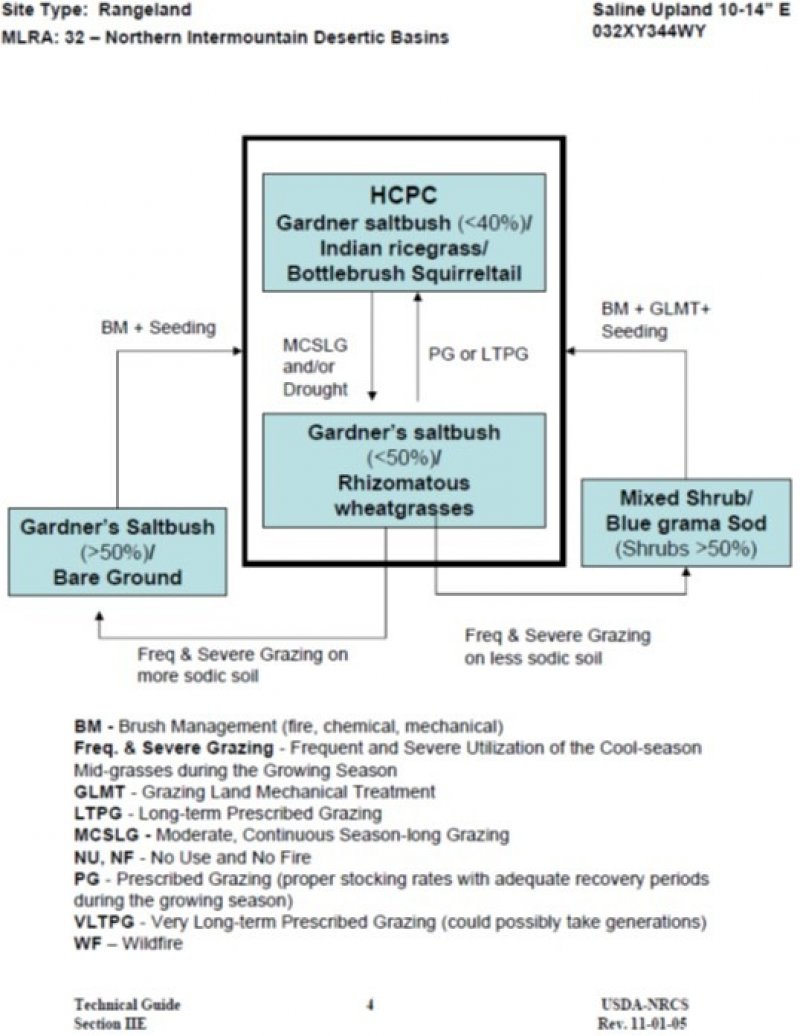
Natural Resources
Conservation Service
Ecological site EX043B23A144
Saline Upland (SU) Absaroka Lower Foothills
Last updated: 5/01/2024
Accessed: 12/22/2025
General information
Provisional. A provisional ecological site description has undergone quality control and quality assurance review. It contains a working state and transition model and enough information to identify the ecological site.
MLRA notes
Major Land Resource Area (MLRA): 043B–Central Rocky Mountains
Major Land Resource Unit (MLRA) 43B: Central Rocky Mountains
43B – Central Rocky Mountains – The Central Rocky Mountains extends from northern Montana to southern extent of Wyoming and from Idaho to central Wyoming. The southern extent of 43B is comprised of a combination of metamorphic, igneous, and sedimentary mountains and foothills. Climatic changes across this extent are broad and create several unique breaks in the landscape.
Further information regarding MLRAs, refer to: United States Department of Agriculture, Natural Resources Conservation Service. 2006. Land Resource Regions and Major Land Resource Areas of the United States, the Caribbean, and the Pacific Basin. U.S. Department of Agriculture Handbook 296.
Available electronically at: http://www.nrcs.usda.gov/wps/portal/nrcs/detail/soils/ref/?cid=nrcs142p2_053624#handbook.
LRU notes
Land Resource Unit (LRU) 43B23A: Absaroka Lower Foothills
Based on the shifts in geology, precipitation patterns and other climatic factors, as well as elevations and vegetation, the Absaroka Range was divided into LRU 23. Further division of this LRU is necessary due to the gradient moving from the foothills to the summit, as well as aspect shifts (north/east face versus south/west face). Subset A is set for the lower elevations within the foothills with 10 to 14 inches of precipitation. To verify or identify the LRU A (the referenced LRU for this ecological site), refer to the Wyoming LRU matrix key contained within the Ecological Site Key. This particular LRU occurs along the eastern lower foothills of the Absaroka Range. This LRU starts north of Clark, WY and runs to the Thermopolis, WY area. Once the foothills cross into the Northern Beartooth Range, the climatic patterns and elevational changes shifts the plant community and allows for a break in LRU's near the Montana state line. As the LRU follows to the south and tracks east with the intersection of the Absaroka and Owl Creek Ranges, the face changes aspect and geology creating a shift in plant dynamics and a break in the LRU. The extent of soils currently correlated to this ecological site does not fit within the digitized boundary. Many of the noted soils are provisional and will be reviewed and corrected in mapping update projects. Other map units are correlated as small inclusions within other MLRA’s/LRU’s based on elevation, landform, and biological references.
Moisture Regime: Aridic Ustic or Ustic Aridic – Progressive Initial mapping has shown that soil correlations completed prior to 2014 were identified as ustic aridic, after further evaluation of climatic and soil taxonomy information the proper moisture regime is aridic ustic. Both are recorded here until an update project is completed to correct the previous correlations.
Temperature Regime: Frigid
Dominant Cover: Rangeland – Sagebrush Steppe (major species is Wyoming Big Sagebrush)
Representative Value (RV) Effective Precipitation: 10-14 inches (254 – 355 mm)
RV Frost-Free Days: 80-110 days
Classification relationships
Relationship to Other Established Classification Systems:
National Vegetation Classification System (NVC):
3 Xeromorphic Woodland, Scrub & Herb Vegetation Class
3.B Cool Semi-Desert Scrub & Grassland Subclass
3.B.1 Cool Semi-Desert Scrub & Grassland formation
3.B.1.NE Western North American Cool Semi-Desert Scrub & Grassland Division
M169 Great Basin Saltbush Scrub Macrogroup
G301 Atriplex corrugate – Artemisia pedatifida – Picrothamnus desertorum Dwarf-Scrub Group
CEGL001439 Atriplex gardneri – Bud Sagebrush Dwarf-shrubland
CEGL001445 Atriplex gardneri / Pascopyrum smithii Dwarf-shrubland
Ecoregions (EPA):
Level I: 10 North American Deserts Level II: 10.1 Cold Deserts
Level III: 10.1.18 Wyoming Basin
Level IV: 10.1.18.b Big Horn Basin and
10.1.18.d Foothills and Low Mountains
Ecological site concept
• Site does not receive any additional water
• Slope is < 30%
• Soils are:
- saline, sodic, or saline-sodic
- Shallow, moderately deep, deep, or very deep (> 10" (25 cm) deep))
- With < 3% stone and boulder cover and < 20% cobble and gravel cover
- Not skeletal (<35% rock fragments) within 20” (51 cm) of mineral soil surface
- Textures usually range from very fine sandy loam to clay loam or clay.
Saline Upland ecological site exist on well drained soils, derived from alkaline or sodic residuum weathered from a composite of sedimentary sources. Saline Upland spans all soil textures (sandy through clayey) grouping them based on the chemical similarities. There is a range of response based on textures varying in production and management responses between those sites that are sandy across to those sites with higher clay content, further exploration is needed to determine if division of the site is warranted. The need may exist to separate saline/sodic soils that are influenced strongly by gypsum or calcium carbonate accumulations; however, verification with soil laboratory data samples are needed.
Associated sites
| R032XY322WY |
Loamy (Ly) 10-14" East Precipitation Zone Loamy sites are found on various upland positions where inter-bedded shales and sandstone formations create intermixed pockets with saline upland sites. Loamy occurring on concave areas where salts have been flushed lower in the profile, encouraging more desirable species to grow. |
|---|---|
| R032XY340WY |
Saline Lowland Drained (SLDr) 10-14" East Precipitation Zone Saline Lowland Drained sites are found on relic stream terraces where down-cutting has removed the water table from reach of the plant community but receives some overland flow. As move up the landform, off of old floodplains/stream terraces, the site will transition into Saline Upland. |
Similar sites
| R032XY144WY |
Saline Upland (SU) 5-9” Big Horn Basin Precipitation Zone Saline Upland 5-9 |
|---|---|
| R032XY244WY |
Saline Upland (SU) 5-9” Wind River Basin Precipitation Zone Saline Upland 5-9 |
Table 1. Dominant plant species
| Tree |
Not specified |
|---|---|
| Shrub |
(1) Atriplex gardneri |
| Herbaceous |
(1) Achnatherum hymenoides |
Legacy ID
R043BX544WY
Click on box and path labels to scroll to the respective text.
